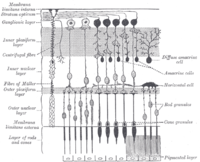
Photo from wikipedia
The cross-sectional area of myelinated axons increases greatly during postnatal development in mammals and is an important influence on axonal conduction velocity. This radial growth is driven primarily by an… Click to show full abstract
The cross-sectional area of myelinated axons increases greatly during postnatal development in mammals and is an important influence on axonal conduction velocity. This radial growth is driven primarily by an accumulation of neurofilaments which are cytoskeletal polymers that serve a space-filling function in axons. Neurofilaments are assembled in the neuronal cell body and transported into axons along microtubule tracks. The maturation of myelinated axons is accompanied by an increase in neurofilament gene expression and a decrease in neurofilament transport velocity, but the relative contribution of these processes to the radial growth is not known. Here, we address this question by computational modeling of the radial growth of myelinated motor axons during postnatal development in rats. We show that a single model can explain the radial growth of these axons in a manner consistent with published data on axon caliber, neurofilament and microtubule densities, and neurofilament transport kinetics in vivo. We find that the increase in the cross-sectional area of these axons is driven primarily by an increase in the influx of neurofilaments at early times and by a slowing of neurofilament transport at later times. We show that the slowing can be explained by a decline in the microtubule density.
Journal Title: Molecular biology of the cell
Year Published: 2023
Link to full text (if available)
Share on Social Media: Sign Up to like & get
recommendations!